The mysteries of quantum chromodynamics: from quarks to the sexy sexaquark
One the comment reacting to one of my last Steemit post on dark matter triggered a discussion on elementary particles and how composite systems could be formed out of them.
Just to start with a definition, ‘elementary’ refers to an object (or particle) that does not contain any substructure, whilst ‘composite’ refers to an object made of some constituents (that could be elementary or not).
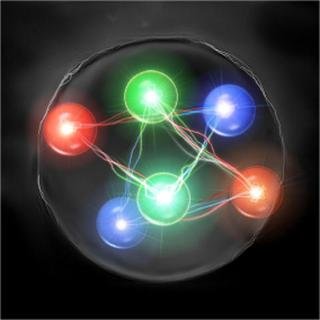
[image credits: Wikipedia]
With this article, I would like to come back to this discussion and give more details about how composite systems are formed on the basis of quantum chromodynamics (the theory of the strong interactions).
When one mentions strong interactions and the composite systems that could originate from it, one immediately thinks about neutrons and protons.
These are very well known composite systems made of quarks, that lie at the basis of all matter that is around us. But we can go to more exotic stuff.
Very recently, the existence of a particle named a sexaquark has been revived.
The latter (illustrated with the picture on the right) has indeed been the focus on some research very recently (see here for instance), as it consists of a potentially new stable particle that could account for the dark matter pervading the universe.
[ Yes, dark matter again ^^ ]
INTRODUCING ATOMS
Before entering the sexaquark topic, let us start with quarks.
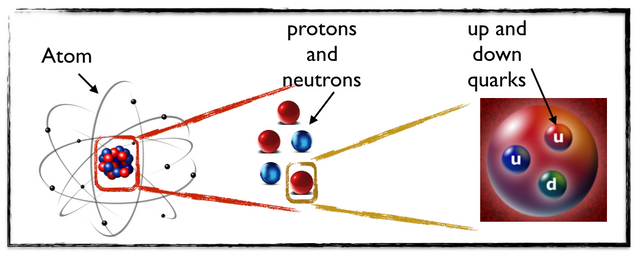
[image credits: homemade (from stuff available everywhere)]
One can recognize on the leftmost part of the above picture a beast that is called an atom.
From atoms, one can build molecules and actually all matter that lies around us. But here, I do not intend to build stuff by gluing atoms together. I will instead do the opposite and decompose atoms in their constituents.
Atoms are not elementary and contain by definition a substructure. There is nothing really new here, and this is well known for more than 100 years.
Atoms are made of a core, the atomic nucleus, and peripheral electrons whose number varies from one atomic species to the next one.
Atomic nuclei are not elementary and feature a substructure. Atomic nuclei are indeed made of protons and neutrons, the exact number of constituents depending once again on the atomic species.
NEUTRONS AND PROTONS
Neutrons and protons are the constituents of the atomic nuclei. They are however not elementary and exhibit a substructure as well. As promised, we need to go down to quarks…
Neutrons and protons are complicated objects but in a simplistic picture, one can see neutrons and protons as made of three quarks each.
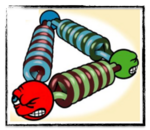
[image credits: Nobel Prize]
Quarks are elementary particles, and two species of them (up quarks and down quarks) are sufficient to explain how all matter around us is formed (okay, together with electrons and in some sense neutrinos but this is off topic).
One example is shown on the picture here on the left, where three quarks are bounded together and form a proton (or a neutron as here we do not know).
Whilst electromagnetic interactions explain how electrons and nuclei form atoms, the structure of the atomic nucleus results from the strong interactions only.
QUANTUM CHROMODYNAMICS
To repeat the last sentence, the fact that protons and neutrons are glued together inside the atomic nuclei is a result of quantum chromodynamics, the theory of the strong interactions.
Strong interactions have two roles. Firstly, protons and neutrons can form composite states (or in other words atomic nuclei), and secondly quarks can also form composite states (like protons and neutrons, but not only).
But how does that work in a few words?
The charge corresponding to the strong interactions is named the color charge and it can be either red, blue or green. With the anticolors, we also have the antired, antigreen and antiblue colors. In total, three color and the three associated anticolors.
The rule to form a composite object is easy: this object can only exist if it is white (i.e., colorless).
COMPOSITE STATES MADE OF QUARKS
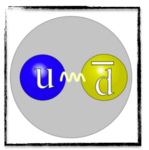
[image credits: Wikipedia]
The easiest way to form a composite state made of quarks is to take one quark of a given color, and one antiquark of the same anticolor.
Red plus antired indeed gives back white, as blue plus antiblue or green plus antigreen.
Those particles are named mesons and we have discovered a whole zoo of them during the last century. One example is shown on the picture on the right: one up quark and one down antiquark are glued together and form a pion.
The quark species can be totally random, the only important point being that the color of the quark equals the anticolor of the antiquark.
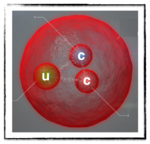
[image: CERN]
Another way to form a colorless state is to take three quarks: one red, one green and one blue. The sum of the colors gives back white.
Examples are the proton and neutron discussed above, but also the Xi-c-c illustrated on the left which I have talked about in an earlier post.
We today know that there is a full zoo of particles are made of three quarks, and they are called baryons.
Composite systems made of four or five quarks can in principle be constructed too. For instance, two quarks of any colors and two antiquarks of the same anticolors yields a colorless system. We can similarly take 4 quarks and one antiquark to make something white. A small reward for the first one who explains me how ;)
All these particles are predicted by the theory, and tetraquarks and pentaquarks have been recently observed and the study of their properties is now on-going.
SEXAQUARKS OR DIBARYONS
In contrast to what have been said above, particles made of six quarks, named sexaquarks or dibaryons, still evade detection so far.

[image credits: Wikipedia]
This was kind of proposed 40 years ago and resurrected earlier this year. A sexaquark, illustrated here on the left, is a system made of six quarks: two up quarks, two down quarks and two strange quarks.
I did not mention it that far, but there are six different quark species and up, down and strange quark are half of these.
Concerning color, we have two red quarks, two blue quarks and two green quarks. The sum is thus white (in short, it works).
Calculations have shown that this particles is light and (meta)stable. It actually takes more than twice the age of the universe to decay.
Data constrains the existence of such a particle, and it turns out that it is still allowed. The interesting point is that the properties of the sexaquark particle match those expected from a dark matter particle and it can additionally gives a hint of the matter-antimatter asymmetry in the universe.
That is a lot for a single guy!
DISCUSSION AND REFERENCES
In this article, I discussed quantum chromodynamics and how composite systems can be made of quarks. On top of the well known mesons and baryons, I briefly introduced the tetraquarks and pentaquarks that are more recent.
But I wanted to focus on something more exotic: the very freshly proposed sexy sexaquark, a particle made of six quarks. This particle has very nice advantages.
The only issue is that it has not been discovered so far, and that it is actually hard to discover. Detection strategies however exist, as hundreds or thousands of sexaquarks may be hiding in LHC data.
But for the moment, the related analyses are still not undertaken (at least to my knowledge that is only based on public facts). The reason is simple: the proposal for such a particle is fresh and the attention needs now to shift to it.
More information on sexaquarks can be found in this scientific article. For a basic introduction on quantum chromodynamics and particle physics, this book is my favorite.
For more discussion on this topic (or anything related to science), please join us on steemSTEM. SteemSTEM is a community driven project which seeks to promote well written/informative Science Technology Engineering and Mathematics postings on Steemit. More information can be found on the @steemstem blog.
A pentaquark would have to be made of a red, blue, and green quark combined with a fourth quark of any color and its antiquark?
That is correct :)
Nice.
Before I got to this sentence, my question was going to be what the properties of a sexaquark would be. But does this imply that a sexaquark may itself be a dark matter particle? Or just a particle with shared traits? How would we go about telling the difference?
The guy is stable and very weakly interacting (it does not couple to most particles). Those are the basic properties for a dark matter particle. Its properties then allow it to escape all direct dark matter detection bounds, and it could even help to explain star formation.
So, if the sexaquark exists (it is so far predicted theoretically but not observed), it could satisfy all the requirements of dark matter.
Every time I read the word quark, I always remember the subatomic duck joke, it says "quark" hahaha
We Germans would say: So'n Quark! (which roughly translates to "what stupid thing")
Quark is also a German cheese, isn't it? I laughed a lot the first time I saw that :)
Not cheese. Uh... the thing like Yoghurt, just harder.
looks it up
lol that is the result, how appropriate:
Yeah I was indeed referring to the yoghourt/cheese thing. It is funny the physics part is given with so many details. I was not expecting this.
Yeah it is a good one ^^
this is good good good post
thank you
https://steemit.com/@tisko
Thanks. But if I were you, I would stop self-advertising yourself when commenting (as you may have noticed, some (not me) are flagging for this).
nice post. upvoted
Thanks!
nice post!! i want to resteem it. after that, i will read many times it!
Thank you! :)
I actually do my master thesis on Sexaquarks. Cool to see it being talked about here.
Wow! This is really cool and welcome back to Steem! Where are you doing your master thesis, and with who?
Can you also please consider reaching us on the steemstem discord server?
Definitely worth an upvote and a resteem :)
Thank you!